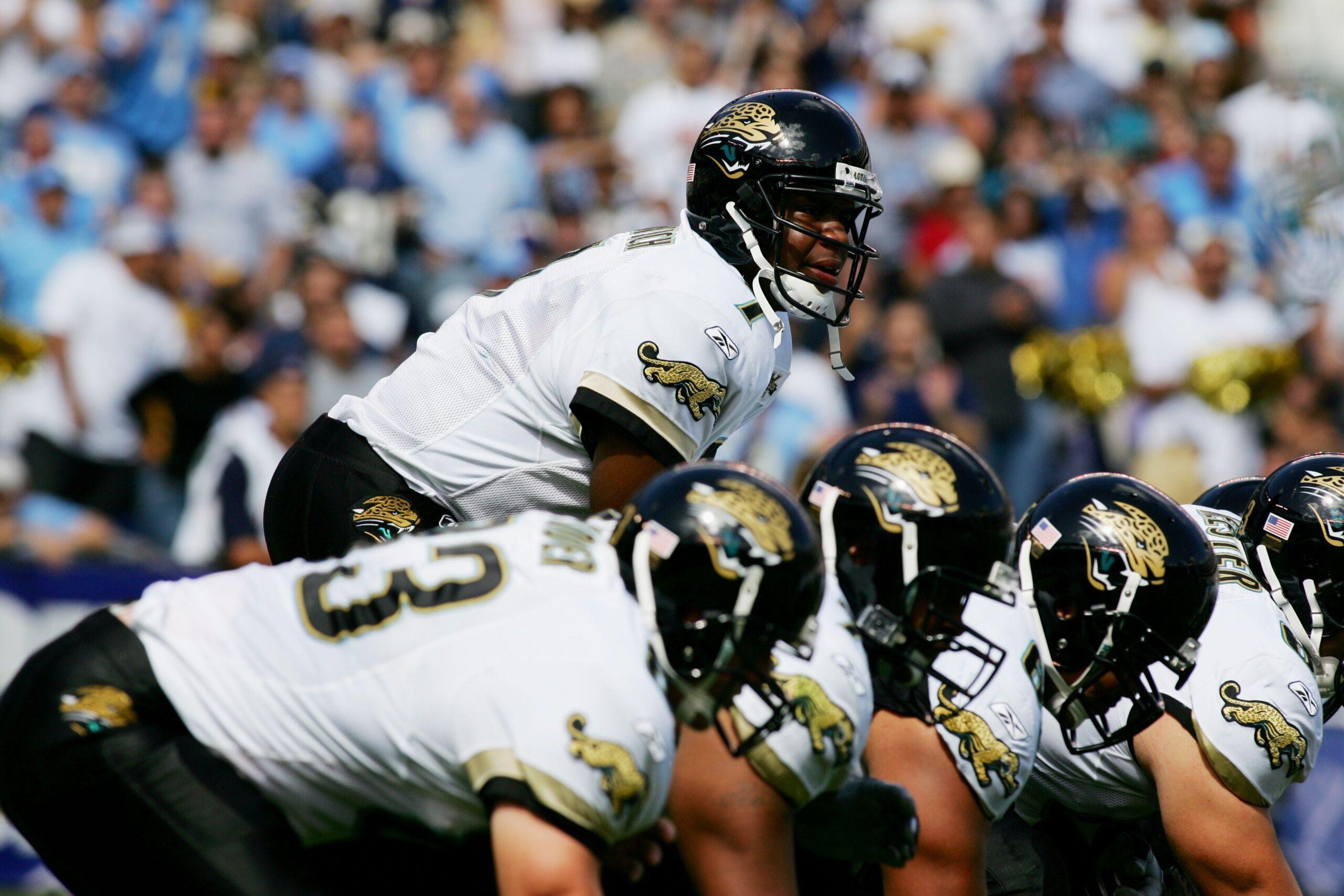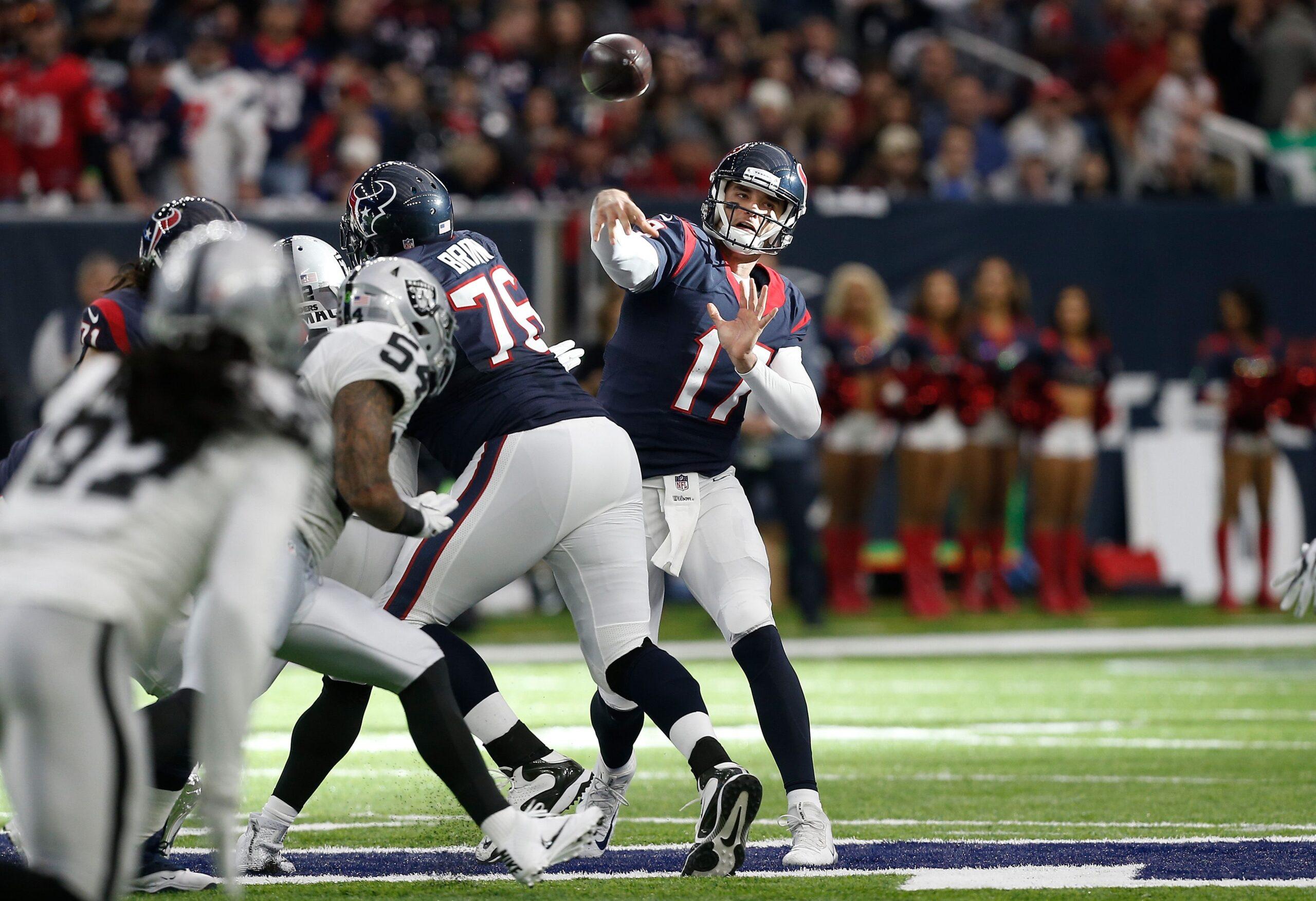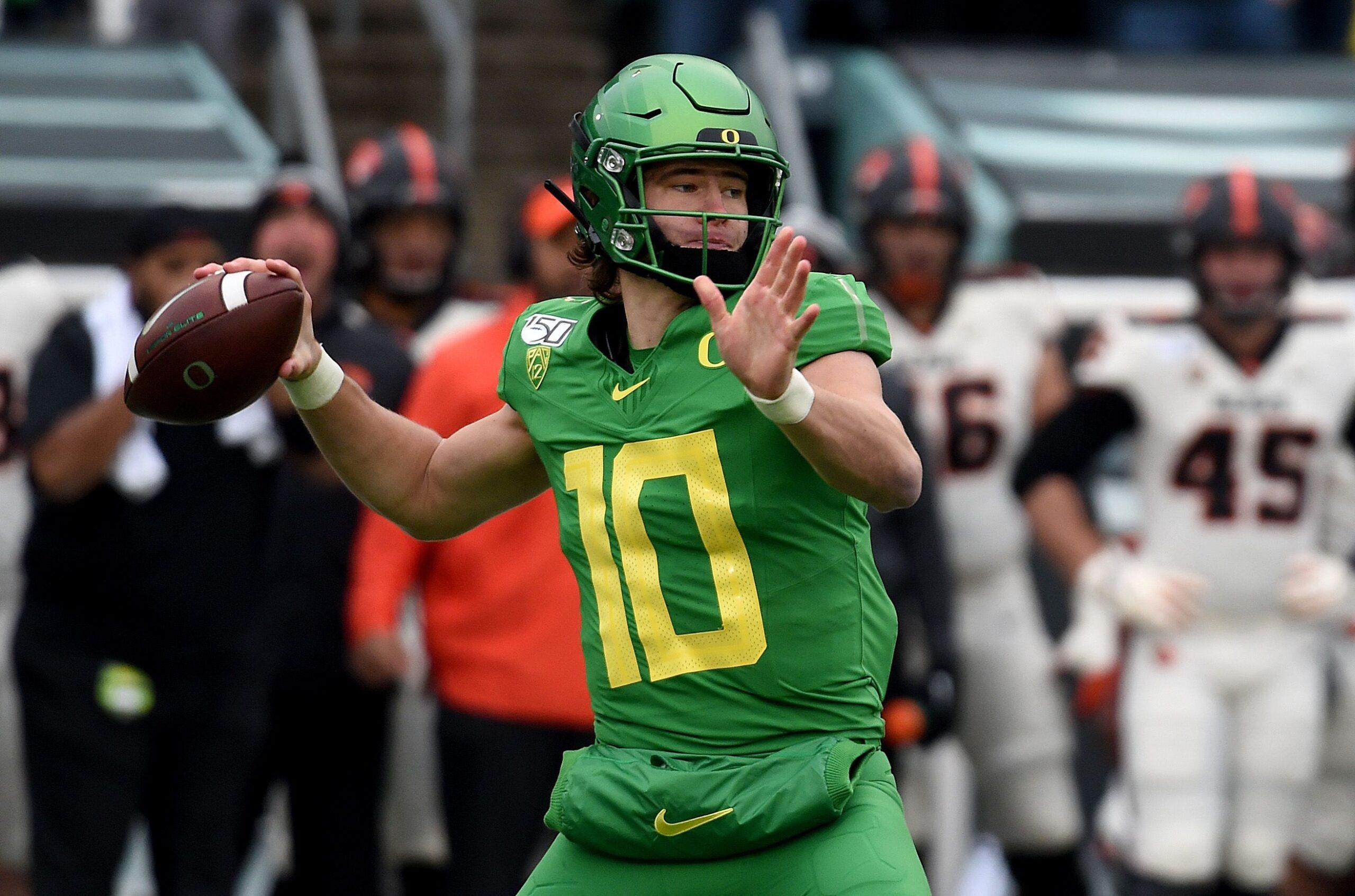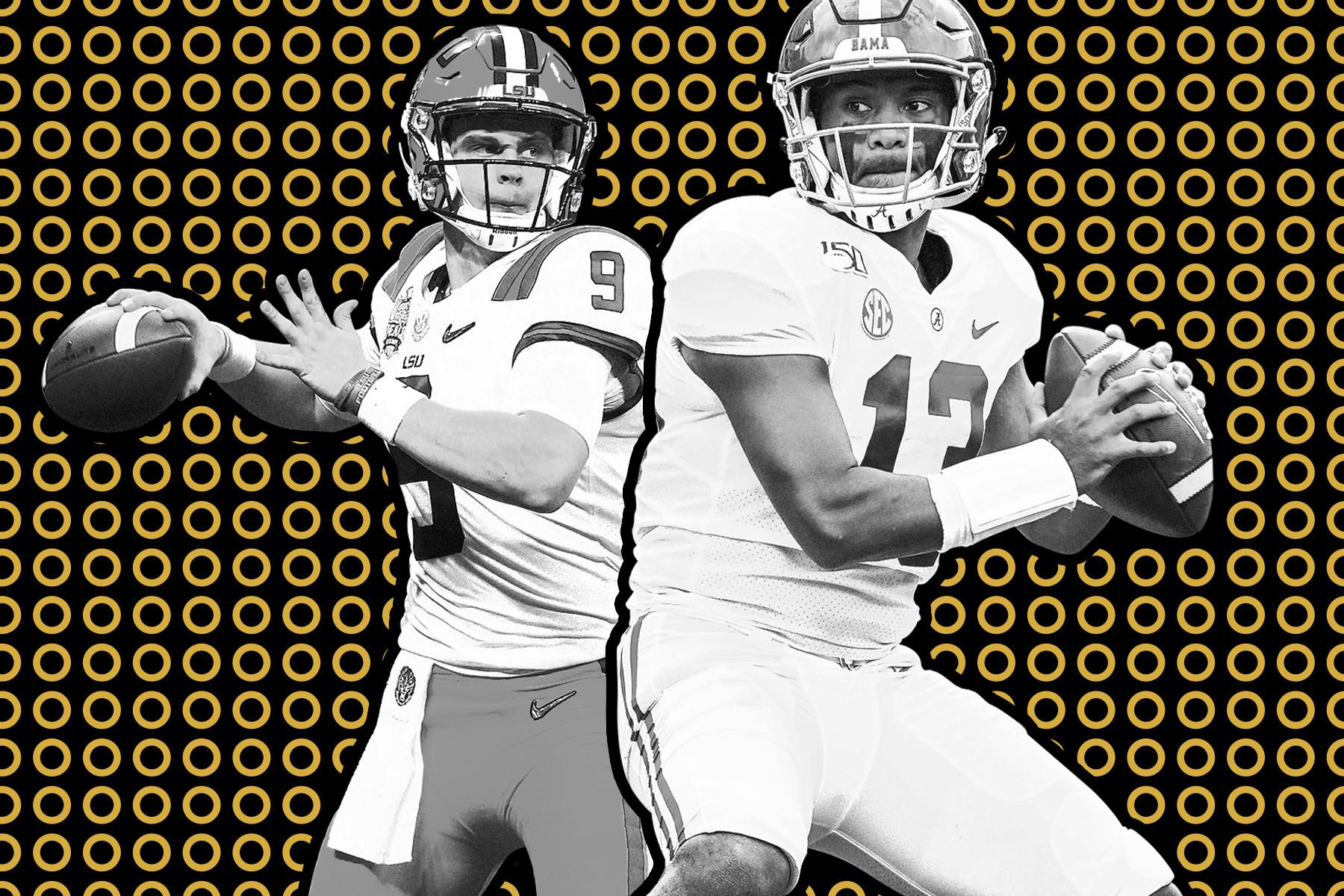Byron Leftwich was 23 years old the first time that someone told him he was too tall. It was February 2003, just a few days before he was set to attend the NFL scouting combine. The league’s rumor mill was already churning away, and Leftwich’s agent—longtime NFL power broker Tom Condon—had gotten wind of some distressing gossip. “I remember him saying, ‘Everybody’s talking about this 6-foot-6 thing,’” Leftwich says. “And I said, ‘Shit on that. What do you mean?’ I’d never heard this stuff.”
Leftwich is now entering his second year as the Buccaneers offensive coordinator, but 17 years ago he was a top-tier NFL quarterback prospect. In his final two seasons at Marshall, he completed 67.2 percent of his passes while throwing for 8,400 yards with 68 touchdowns. Leftwich finished sixth in Heisman Trophy voting as a senior, one of the best showings ever by a player from the MAC. Equipped with a long, sturdy frame and a powerful arm, Leftwich thought he was blessed with traits that scouts adored—only to find out that some actually viewed those perceived strengths as weaknesses. “A lot of this stuff was new to me,” Leftwich says. “I didn’t find out I dropped the ball [too low] when I threw until I was in the combine. Nobody had told me. I thought it was a good thing.”
Teams were apparently concerned that Leftwich’s imposing size contributed to a slow release. So when it came time to meet with league doctors, he did what other tall people self-conscious about their height have done for centuries: He hunched. “I didn’t want to be 6-foot-6,” Leftwich says now, laughing. “I think I was like 6-foot-5 and something fourths.”
A half-inch here or there may not seem like much, but the world of NFL scouting is governed by precedent—and the league’s history with tall quarterbacks isn’t pretty. Accomplished QBs like Peyton Manning, Ben Roethlisberger, and Cam Newton all stand 6-foot-5, but go any taller and the returns quickly diminish. The list is littered with disappointments like Ryan Mallett, Mike Glennon, Brock Osweiler, and Paxton Lynch. Since 2000, 23 quarterbacks have measured taller than 6-foot-5 at the combine. Just three—Joe Flacco, Matt Schaub, and Josh Freeman—went on to start more than 50 games. Only Schaub has averaged more than 7 yards per attempt in his career.
When I asked a handful of NFL coaches past and present about this phenomenon, the general consensus was that a QB could be too tall. But no one could convincingly explain why. “I suppose if he could be too short, he could probably also be too tall,” says Mike Sullivan, who spent nearly a decade as a QBs coach and offensive coordinator in the NFL. “That’s kind of a chickenshit answer. I’ve never really thought about that.”
There are no hard-and-fast scouting rules against drafting incredibly tall quarterbacks. Most front offices don’t have edicts that forbid taking them, or definitive theories for why most haven’t panned out. “It was never really spelled out in a manual or anything,” says Senior Bowl executive director Jim Nagy, who spent 18 years as an NFL scout. “It’s nothing they ever talked about just because they are so few and far between. You’re rarely dealing with those guys.”
Supremely tall quarterbacks are rare, but this year’s draft just happens to feature two prominent prospects who are exactly 6-foot-6. Oregon’s Justin Herbert has a chance to go in the top five, while Washington’s Jacob Eason could sneak into the first round. They’re poised to become the latest case studies in a seemingly simple football question: Can a QB be too tall?

Joey Roberts has spent a good chunk of his life studying quarterbacks. In the past several months alone, the director of scouting for the Elite 11 QB competition has watched tape on more than 300 of the country’s top high school passers. He has a better sense of where the game is heading than most, and says that recent changes to the sport have brought a new kind of talent to the position. “The days of five-step, seven-step [drops], showing off your arm, putting up big statistics, [winning] Gatorade Player of the Year, national honors, all that stuff [are over],” Roberts says.
“I didn’t find out I dropped the ball [too low] when I threw until I was in the combine. Nobody had told me. I thought it was a good thing.” — Byron Leftwich
Given the demands of the modern NFL, quarterback athleticism has never been more crucial. Nearly all of the league’s best signal-callers have the mobility to make off-schedule throws and pick up yards outside the pocket. Stars like Russell Wilson, Lamar Jackson, and Patrick Mahomes have fundamentally altered our understanding of what quarterbacks should be, and that evolution could turn bigger, statuesque passers into fossils of a bygone era. On the whole, taller QBs lack the quick-twitch movement skills that are now prevalent among the league’s best quarterbacks. Of the 23 players to measure taller than 6-foot-5 at the combine since 2000, 14 tested below the 20th percentile in either the vertical jump or the 40-yard dash. Neither metric is typically associated with QB success, but those results indicate that a lack of athleticism has long been common among taller quarterbacks.
Rob Williams, a renowned kinesiologist and movement specialist who’s worked with quarterbacks at all levels, says that he’s seen similar results in his work. “Inevitably, [they’ve] got poor movement, poor hip mobility, tight hamstrings,” Williams says.
There are no laws of physics that say longer bodies can’t move well. The sports world is filled with examples of supersized athletic marvels, from Julius Peppers to Calvin Johnson. But Williams has a theory that kids who gravitate to quarterback at an early age aren’t trained like other athletes. “He won’t be taught to run like a running back,” Williams says. “He won’t be expected to be as mobile and athletic. Because he’s big. He’s a big guy, and he’ll get away with being OK or better at his position because he’s the big guy with the strong arm.” Williams says he’s tutored NFL quarterbacks who still struggle with even the simplest movement drills. “I’m like, ‘How did you manage to play at the level you play, but you can’t land on one foot without falling over?’”
Some QB experts think how tall a player is matters less than when his growth spurt happened. Eagles quarterback Carson Wentz is 6-foot-5, but tested in the 84th percentile or better in the broad jump, three-cone drill, and 20-yard shuttle at the 2016 combine. Wentz also happened to be 5-foot-8 as a high school freshman, which gave him time to grow into his body. Ryan Mallett, on the other hand, was 6-foot-1 by the time he was in sixth grade. “I think if they grew fast early, they end up being a little bit more stiff,” says Will Hewlett, a private coach with the QB Collective. “[Mallett] had a terribly slow 40 time, but he could throw the ball 90 yards.”
“He won’t be expected to be as mobile and athletic. Because he’s big. He’s a big guy, and he’ll get away with being OK or better at his position because he’s the big guy with the strong arm.” — Rob Williams
At 6-foot-7, former University of Buffalo quarterback Tyree Jackson is one of the tallest QBs ever measured at the combine. That didn’t stop him from running a 4.59-second 40-yard dash and posting a 34.5-inch vertical leap in 2019. But while Jackson towers over his peers now, he was only 5-foot-9 as a high school freshman. “I’ve never felt 6-foot-7, if that makes sense,” Jackon says. “Obviously I’m 6-foot-7, a big guy. But I’ve never really felt like that.”
Jackson, who went undrafted last year before spending this spring with the XFL’s DC Defenders, is an exception among tall QBs. So are players like Lynch and Osweiler, who were both accomplished high school basketball players and impressive athletes. Yet each of those two were held back by other deficiencies that may be even more damning for an NFL quarterback. “Brock was a good athlete, man,” Nagy says. “The least of Brock’s issues were his athleticism and mobility.”

While other kids were having a catch with their fading, middle-aged fathers, Jordan Palmer was tossing the ball around with one of the most gifted throwers to ever walk the earth. Palmer’s older brother, Carson, went on to play quarterback at USC, win the Heisman in 2002, and become the no. 1 pick in the NFL draft. “When I was young, I was just trying to throw the ball as hard as him,” Jordan says now. “It was always about velocity, velocity, velocity.” Palmer, who’s become one of the most sought-after QB gurus in the sport, eventually realized that playing quarterback is more about finding completions than having a cannon. But when he was young, throwing the ball fast and far was all that mattered.
For decades, the kids with the strongest arms tended to play quarterback. How they summoned that strength wasn’t particularly important. Plenty of coaches at the lower levels of football are volunteers who lack knowledge about how to nurture and develop talent. From the time many young QBs pick up a football to the time they finish high school, they operate without informed direction. If the tall freshman with the rocket arm can fire the ball all over the field, it doesn’t really matter how he does it. “With quarterbacks, [coaches will say], ‘Oh, he’s a big kid. He’s got a long arm. All right, let’s see how far he can throw it,’” Williams says. “And that kid will default to extending that arm, having a huge drive and launching the ball. And he’ll get away with that for a little while, but that’ll become his foundational strategy for throwing.”
Quarterbacks with long limbs have elongated releases by nature, and Williams believes that established training methods have only reinforced that tendency. Experts like Williams and legendary quarterback specialist Tom House base many of their teachings on a proximal-to-distal strategy. That means all athletic movements should begin from the center of the body and move outward, as a way to engage the largest muscle groups to create force and power. Picture a figure skater spinning through the air in a tight, compact motion: Velocity comes from the core and rotary movements, not from the limbs. The problem, Williams says, is that quarterbacks have historically been taught the opposite. “Most of these guys have never been coached that way,” Williams says. “They’ve been coached distally. ‘So point your front foot. Point the nose of the ball here. Do this with your hand, do this with your elbow. This is where your feet go.’”
Williams resides at one end of the spectrum when it comes to quarterback training. He’s an evangelist for short, precise throwing motions that maximize efficiency. Hewlett believes there’s more wiggle room. He encourages QBs to embrace their natural style to ensure comfort and flexibility. There have been plenty of tall, fluid quarterbacks who can sling it, but straying too far in that direction comes at a cost. When throwing a football, a player’s upper and lower body are linked. It’s impossible to have a long stride with a quick motion, or vice versa. “A longer-lever guy would struggle, just with pure physics, to get big levers moving faster,” Hewlett says. “You need more momentum. And so they probably rely on driving towards the target more so than a guy that’s 6-foot-2 and compact.”
There’s also plenty of evidence to suggest that long strides and extended windups aren’t necessary to generate elite velocity. Take Aaron Rodgers, who at 6-foot-2 has one of the strongest arms in football history. Rodgers is the poster child for the benefits of a proximal-to-distal throwing strategy. On some of his most impressive passes, his front foot barely flinches. “I use the golf example,” Williams says. “The front foot on a golfer doesn’t move. And now they’re hitting the ball, what, 480 yards? ... Your front leg is useless. It’s basically a post. It should decelerate your hips [to create torque]. And if you’re doing this long distal reaching strategy, you’re taking that advantage away.”
People like to compare baseball pitchers to quarterbacks. But unlike the NFL, MLB has produced tons of tall-player success stories. Think of the 6-foot-10 Randy Johnson terrifying opposing hitters as he stalked around the mound. Long deliveries in baseball can be devastating, but Palmer says there’s a fundamental difference that sets the positions apart. Pitchers have agency. They can choose a pitch and force the batter to respond. By contrast, quarterbacks are reactionary throwers. Even the best-laid plans can disappear as soon as the ball is snapped. “You can be telling yourself, ‘Hey, man, if this curl’s open, I’m going to throw it as hard as I can. I’m going to hit him right in the face.’ All that,” Palmer says. “But then the play happens, and you actually are asked to, in a split second, do something a little different than that.” Sticking in the baseball world, there’s a reason the average shortstop is about 6 feet tall. Playing in the middle of the diamond requires the same quick-twitch flexibility—both as an athlete and a thrower—that’s become necessary for modern NFL quarterbacks.
As QBs ascend through the ranks, they often operate in surroundings that allow their natural throwing talent to take over. But as the level of difficulty increases and those environments begin to deteriorate, those who can’t adapt are destined to become extinct. “I think it stems all the way down to high school, even 7-on-7 in seventh and eighth grade,” Roberts says. “These bigger quarterbacks are asked to do something that they’re really, really good at, and they’re not forced to do the stuff that they’re eventually going to have to do.”
“I think it stems all the way down to high school, even 7-on-7 in seventh and eighth grade. These bigger quarterbacks are asked to do something that they’re really, really good at, and they’re not forced to do the stuff that they’re eventually going to have to do.” — Joey Roberts
Upon reaching the NFL, strong-armed quarterbacks who could once get away with the occasional late throw quickly learn that they’re doomed without anticipation. Lanky quarterbacks used to taking up space in the pocket suddenly realize they have less real estate with which to operate. “In the NFL, I think that’s the biggest adjustment a lot of guys talk about,” Jackson says. “Just being able to make those short, quick movements because you don’t have as much room.”
For Hewlett, the downside of a tall quarterback is rooted more in having a rigid motion than a long one. In certain situations, Wentz has a long, loopy delivery that unfolds slower than virtually any other release in the NFL. But when necessary, he has the ability to quicken his movements to get the ball out fast. “The guys that have the most success are the guys that have the most varied release paths,” Hewlett says. “If they’re longer by nature, they can shorten it up when they need to.”
For a QB with 34-inch arms, Osweiler actually had a quick, compact throwing motion, which Hewlett assumes was the result of a coach overcorrecting the tendencies of a tall quarterback. But by adhering to a stiff, unnatural delivery, Osweiler struggled to make the reactionary plays that have become paramount. “The ultimate type of thrower is one that can adapt,” Hewlett says. “It’s not about having a short, quick release. It’s about matching the release to the environment. To me, the best throwers are the ones that have the most weapons in the bag.”

You can sense the frustration in Williams’s voice when he talks about tall quarterbacks. He knows that most of them are athletically limited. But the maddening part is that they don’t have to be. “I usually end up sitting and just having a hard, frank conversation with them, and saying, ‘There is no reason, at 6-foot-6, you can’t be as athletic and mobile as the guy who’s 6-foot-1,’” Williams says. “There is no anatomical, biomechanical, kinesiological reason that [you’re] not just as athletic and just as mobile.’ And I always defer to basketball.”
Ask a group of NBA fans to name the most athletic players in the league, and they’re likely to mention Russell Westbrook, LeBron James, and Giannis Antetokounmpo, in some order. The heights among that group range from 6-foot-3 to 6-foot-11. In theory, there’s nothing preventing the LeBron James of quarterbacking from emerging, especially as QBs at lower levels get more and more athletic. The question, Palmer says, is what incentive that kid would have to even play football in the first place. “I think the reality is, there’s not that many 6-foot-7 guys who choose quarterback in high school over other sports where 6-foot-7 is a huge asset, like basketball and volleyball,” Palmer says.
“‘There is no reason, at 6-foot-6, you can’t be as athletic and mobile as the guy who’s 6-foot-1. There is no anatomical, biomechanical, kinesiological reason that [you’re] not just as athletic and just as mobile.’” — Williams
For tall standout athletes, the path to professional sports is easier in sports like baseball and basketball—in large part because the trails have already been blazed. A 6-foot-7 phenom is far more familiar to Coach K than Coach O. “There’s no way you’re getting him in football,” Roberts says. “There’s no way. He’s going to play at Duke, and you’re not going to touch him.”
This is how the cycle perpetuates. Few incredibly tall quarterbacks have succeeded in the NFL because few have tried. And few have tried because few have succeeded. “There’s been a million 6-foot quarterbacks and we don’t really take into account the ones that aren’t successful,” Jackson says. “There’s just so [few] of the tall ones, when something doesn’t work out it just might be easier to stereotype it.”
For now, the cycle keeps spinning. Until a promising talent like Herbert or Eason can break it, Leftwich won’t be the last quarterback trying to shrink when the NFL comes calling.
